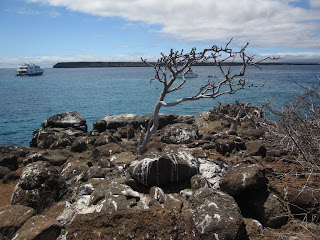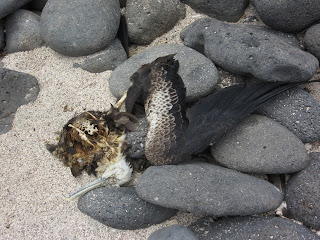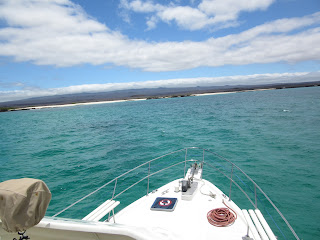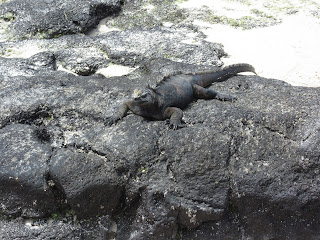A couple of days ago, we’d made reservations to take a day
tour to North Seymour Island that wasn't too far away from Santa Cruz Island. The
National Park guide mentioned the island was one of the smaller ones in the
Galapagos, measuring only 1.9 square kilometers. We had chosen to go there as it was the only one which had the red species of frigate birds and we
hoped to see some more blue-footed boobies too, of course.
Our bus ride to the north part of the island was delayed by hundreds of bottles of beer that had crashed on the road!
From the mainland we had to get a water taxi over to Baltra Island and from there a larger boat to North Seymour located about an hour's journey away.It's so funny looking at this picture of myself with my very red hair as my hair now, over four weeks later, has faded to a very pale blond! I brought some more hair color with me but the setting solution leaked in a plastic bag and I had to throw it out. Good news - less weight to carry. Bad news - I have never had to buy hair color while on one of our overseas adventures and I don't know what my hair will look like when I try something new!
Views en route to North Seymour Island:
What a hard life we lead, I'm sure you must be thinking! Believe me, rarely a day goes by when we don't voice our lucky blessings to each other.
Our boat:
We had to take turns going in an inflatable boat called a tender or zodiac to be dropped off at North Seymour Island as it was only capable of taking about eight passengers.
The first 'wildlife' we saw on the island was a bright red Sally Lightfoot crab! The distinctive crab, found along rocky shorelines, follow the movements of the tide, scavenging for scraps and spooning up pieces of algae on specially adapted pincers.
Our guide, Diego, reassured the group that whatever time of year tourists come to North Seymour, there would always be some sort of courtship, mating, nesting or chick-rearing to observe and we weren’t disappointed either.
The land iguana changes to green from January through June, we were told.
Diego took us on a rocky, circular trail that was about 1.5 miles long and which led through some of the largest and most active seabird-breeding colonies in the islands.
Almost hidden in the bush was a magnificent frigate. Its red pouch develops when the male finds a female.
The tan or brown head type was called an immature gray frigate – what a politically incorrect name in this day and age!
The white-headed magnificent frigate stays in the bush and only flies when it’s four months old. Both the male and female parents bring food to the frigate. The guide smiled as he remarked what a boring life the young frigates have for four months as they don’t move for that entire time. If they do, they fall and die!
Traipsing through the bush looking for more animals!
Size and color differentiate a male and female land iguana. The male iguana was ‘calling’ a female iguana to attract it.
This baby magnificent frigate was only five weeks old. How soft and cuddly he looked!
Diego said the adult on the right was from another family.
The frigates are almost totally white when they’re born except for a few black features. They change color at three years of age. That is when they lay eggs.
It was amazing how close we were able to get to their nests.
This frigate had been named Helmut by whom and when, I don't know! Apparently, he’s always in the same spot. The frigates have a 50-60-year life span.
Land iguanas normally have a more intense color during the mating season; in the ‘off season’ they are black.
This male magnificent frigate was making his presence known to nearby females!
This cactus has beautiful yellow flowers in the spring.
Land iguanas eat cactus and vary in color from island to island. Their mating season is four months long and then they lay from five to twelve eggs.
The eggs hatch in four months. They are normally vegetarians but last year was so dry there was no food and they began eating small animals to survive.
You can tell from all the bird poop that North Seymour Island was the place to come to see many birds!
The colors were quite startling with the reddish grasses, the pure white egret, the bright blue sky and the turquoise waters.
As we walked along the water's edge, Diego mentioned that baby sea lions, born from September to April, can stay under water for 15-20 minutes at a time.
The sea lions only use North Seymour as a nursery to have their babies and then they go to close islands to live. That explained why there were so few here.
The Galapagos sea lion are relatives to the larger California sea lion.
When El Nino happened, the water was too warm for them and they and many birds died.
It was so much more fun admiring the sea lions here than in any of the Sea Worlds we've been to with the children.
The male frigate was still trying to attract a female!
Once again we were lucky enough to come close to the blue-footed boobies! The feet turn blue later, we were told.
Diego told us there are three varieties of boobies in the Galapagos with the blue-footed variety being the most widespread but the least numerous. They occupy small colonies all over the islands but prefer to breed on those south of the equator.
The female lays up to three eggs on the nest and incubates them with her feet. If food is scarce, the first-born hatchling will eats its less fortunate siblings, a way of guaranteeing that at least one will survive. I hope you're not sick and tired of seeing photos and learning more about them as we saw many more on another island!
What a shame there was some garbage near the waterfront that had likely come in with the tide.
The national park only allows 16 people per group to stop at the island; already there were 6 groups scattered across the small island.
Diego told us this was the dry season and that red, orange and yellow colors would predominate in the wet season. I figured we must have been on the verge of the wet season because of the reddish tundra over so many parts of the island.
This sea lion, only a few days old, made a bleating sound like a sheep.
After returning to the boat by tender, we had lunch while motoring to our next stop.
I remember the first apartments I ever had on O'Connor St. in Ottawa had a galley kitchen. It was a darn sight bigger than this one!
Another from the cute bathroom sign collection!
I forgot to write down what fish swam alongside the boat so the photo will have to suffice!
We could see Mosquera Island in the distance. When we booked the boat trip a couple of days ago, it was supposed to have included a stop there too.
We were heading toward Las Bachas Beach located on the northern tip of Santa Cruz Island. There we would have about 90 minutes to snorkel, swim or just laze about on the beach.
We couldn't wait to get ashore as the strip of white beach and the clear green waters looked so inviting. We just had concerns whether the short wet suits we'd rented would be sufficient as we'd heard varying opinions as to the coldness of the water.
We had a wet landing, i.e. water up to our knees. The landing over on North Seymour Island by contrast had been a dry landing.
The sun shone and it was beautiful out. We only swam in shallow water near the tidal pools so probably didn’t need the wet suits at all but it was better to be safe than sorry, we figured.
It was fun sharing the beach with the marine iguanas who were prevalent among the rocks.
The marine iguana is unique in the world and endemic to the Galapagos Islands. It was easy to confuse the iguanas with lava rocks as they blended in so perfectly until they made a characteristic sound.
That sound is the only noise they make and is the only way they can eliminate excess salt. They rest in the rocks to recover energy and warm up. They looked like mini dinosaurs and mythological dragons seen in so many children’s fairy tales!
After having so much fun exploring the tidal pools, Diego took us to a brackish lake a little ways inland.
Almost immediately we saw a flamingo and Diego mentioned that in almost 30 years as a guide, he’d only ever seen a total of 11 before. We must have brought him good luck!
They breed on the west side of Santa Cruz Island and not here on the north side which explained how rare a sighting of them is.
Zachary and Suellen: There weren't many shells on the beach but I collected a few to show you when we get home.
After exploring other areas to snorkel, we returned to the brackish lake to gaze at the flamingo.
I was so thankful my camera had a good telephoto lens!
As we wandered along the beach, we noticed depressions in the sand. They were sea turtle nests. The turtles are born at night and head directly to the sea. Otherwise, they will be killed by predators during the day.
We saw a sea urchin and more marine iguanas that blended in so perfectly with the black rocks it was almost impossible to see them. The marine iguanas eat algae.
Judy: I imagine one of these marine iguana photos would make a good puzzle unless it might drive you to distraction because of hardly any variation in color. What do you think?
What a fun day we'd had discovering the magnificent frigates and other animals on North Seymour Island, then snorkeling on Las Balchas Beach and finding a lone flamingo. Too bad our excursion was over far too soon!
Next post: Onto enchanting Isla Isabela for a few days.
Posted on November 16th, 2017, from Uyuni, Bolivia.









































































































































Thanks mom for getting me some shells! Why didn't you get an underwater camera for snorkeling?
ReplyDeleteYour travel log reads like a National Geographic's accounting of the extraordinary characters that grace the land, the skies and the waters of the Galapagos !! As you know, my dream island vacation!! Savour every minute ! Love to you both. xoxox
ReplyDeleteZachary,
ReplyDeleteSure should have gotten an underwater camera for this trip after not having one for the Great Barrier Reef a couple of years ago. IF we ever know we'll see more underwater wildlife, I promise myself I'll get a new camera!
Lina,
ReplyDeleteWhat an eloquent way of describing what we were so lucky to experience in the Galapagos! Believe me, there was a far more exciting tour we had over on Isla Isabela; one of our best days ever, we agreed. Just wait a few days until I post it and see if you agree!
The pictures look amazing. I think you look great in all of your photos, your hair looks great. I love how cute sea lions can be, and the birds too. The crab photo looks really weird only because it looks like he is climbing a rock upward or something. You and Steven look like it was relaxing to be on the water. I love readying your adventures so far. Can't wait to hear more about it when you get back.
ReplyDeleteHadassah,
ReplyDeleteWhat a sweetie you are to comment on how I look in the photos. I do admit to only selecting ones I like of myself, however. I haven't had a hair cut since we left three and a half months ago so not so sure you'd still think much of my shaggy locks!
You were absolutely right that the crab was indeed climbing upwards on the rock so it was a weird angle for the photo.
See you really soon now!